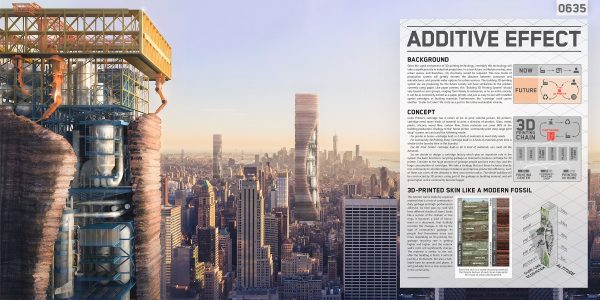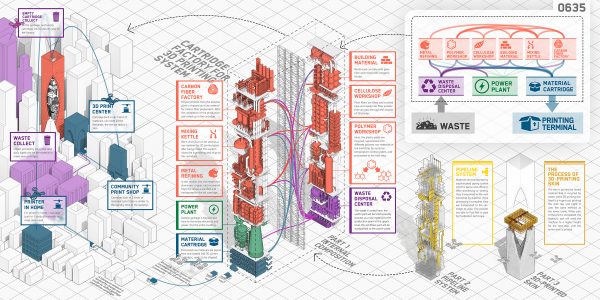Honorable Mention
2018 Skyscraper Competition
Jinzi Wei, Yiliang Shao
China

Background
Since the rapid evolvement of 3D-printing technology, inevitably this technology will take a significant role in industrial projections. In a near future, as lifestyle evolves, new urban spaces, and therefore, city structures would be required. This new mode of production system will greatly shorten the distance between consumer and manufacturer, and provide wider options for urban services. The building 3D-printing system we are proposing for the future society will have similarities to the printers currently using paper. Like paper printers, this “Building 3D Printing System” should vary based on user groups, ranging form family to enterprise, or to an entire society. It can be as commonly owned as a paper printer, and just as easy to use with installed spatial cartridges, as building materials. Furthermore, the “cartridge” itself carries another “Crater to Crater” life circle as a part to the entire sustainable scheme.
Concept
Color Printer’s cartridge has 4 colors of ink to print colorful picture, 3d printer’s cartridge need seven kinds of material to print a diversity of product. Glass, metal, plastic, silicone, wood fiber, carbon fiber, these materials can cover 98% of the building production. Analogy to the” home printer -community print shop-large print shop” system, we can build the following mode:
For printer in home—cartridge built-in 3 kinds of materials to meet daily needs
For community 3d printing shop: Cartridge built-in 5 kinds of materials (print time is similar to the laundry time in the laundry)
For 3d print center: cartridge built-in all 7 kind of materials, can meet all the demands
So, we decide to design a cartridge factory which play an important role in the system, the basic function is recycling garbage as material to produce cartridge for 3d printer. Consider to the huge amount of garbage people produce every day, and the huge consumption of cartridges. We take a strategy that put those factories directly into community to shorten transport distance and improve production efficiency, each of them can cover all the demand in their own service radius. The whole building will be constructed by 3d printer, using part of the garbage as building material, and will grow higher as the community become bigger.
Skin like a modern fossil
The exterior wall is made by a special material that is a mix of community’s daily garbage and high-performance adhesive. As time pass by, wall will have different shades of layers, looks like a section of the stratum or tree rings. It becomes a kind of monument or a document, that dutifully recorder the changes in life by the type of community’s garbage. As people find themselves more and more depending on 3d printing, the garbage recycling rate is getting higher and higher, and the exterior wall’s color will significantly change. The material is similar to the soil, after the building is finish, it will not just be a monument, but also a habitable base for animals and plants. It will gradually form a new ecosystem in the community.


This work is licensed under a Creative Commons License permitting non-commercial sharing with attribution. https://creativecommons.org/licenses/by-nc-nd/4.0/



